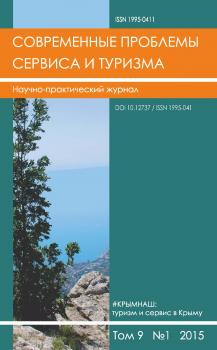Tula, Tula, Russian Federation
An interest in noble culture grows in Russia nowadays. A lot of noble estates are restored and An interest in noble culture grows in Russia nowadays. A lot of noble estates are restored and become objects of farmstead tourism. About 300 ancient estates are located in Tula region, but only the few can be used as tourism objects now. In this work the most known estates of Tula region, which are widely used in tourist programs and included in pilot model of the project «Tourist cluster «Russian estates» were allocated. Also, the distribution of estates in districts of Tula region is shown. For the evaluation of attractiveness of noble estates of Tula region the model of the investment cadastre was used and 25 factors of their investment appeal are shown. Based on this model the analysis of potential use of architectural heritage of noble estates and possibilities of realization of their functions was carried out. Three most perspective estates from the point of view of further restoration and the condition of their functional use were allocated. The cartographical data presentation about opportunities of preservation and further use of noble estates in tourist programs is given in the article. The special attention in work is paid to the estate of railway «kings» - barons fon Meek. Brief historical information about owners of the estate is given, the results of the analysis of safety of the building and the opportunities of its restoration and further use are shown. In this work it is shown that restoration of noble estates will promote considerable revitalization of regional tourism.
noble estates, tourist attractiveness, farmstead tourism, architectural heritage, investment cadastre, regional tourism, tourist programs, Tula region.
После долгого забвения растет интерес общества к дворянской культуре, очагами которой были многие помещичьи усадьбы [3]. Наблюдается тенденция восстановления дворянских гнезд, особенно тех, с которыми были связаны деятели истории и культуры [7]. Таких имений в Тульской области немало, но лишь немногие из них используются как историко-мемориальные объекты и комплексы. Среди наиболее известных следует выделить 14 усадебных комплексов [6] (Табл. 1). Шесть действующих усадеб включены в пилотную модель проекта «Туристический кластер «Русские усадьбы», представленную на Координационном совете федеральной целевой программы «Развитие внутреннего и въездного туризма в РФ (2011-2018 гг.)» и рекомендованную для включения во 11-й этап вышеуказанной программы1. Они же являются и наиболее популярными по посещаемости туристами2. Расположение этих усадеб показано на рис. 1. Всего на территории Тульской области расположено около 300 усадеб, наибольшее их количество сосредоточено в г. Тула, Щекинском и Белевском районах. Дворянские усадьбы Тульской области все больше интересуют историков и краеведов, однако материалы по их исследованию недостаточно систематизированы.
1. Istoriya Veneva / Venevskiy uezd: sayt Denisa Makhelya. URL: http://www.veneva.ru/history.html (Data obrashcheniya: 05.06.2015).
2. Krasnobaev I. B. Arkhitekturnoe nasledie sel´skikh dvoryanskikh usadeb Kazanskogo Povolzh´ya: potentsial sokhraneniya i ispol´zovaniya: Avtoref.... kand. arkhitektury. Kazan´, 2009. 24 s.
3. Morozova N. G. Chem interesen muzey-usad´ba dlya sovremennogo cheloveka? K voprosu ob istorii muzeev-usadeb v Rossii. Sovremennye problemy servisa i turizma. 2015. T. 9. № 2. S. 86-91.
4. Ponomareva I. Yu., Malafiy A. S. Sotsial´nye funktsii ustoychivogo razvitiya turizma v Tul´skoy oblasti. V kn.: «Faktory ustoychivogo razvitiya regionov Rossii: monografiya» / Pod obshch. red. S. S. Chernova. Novosibirsk: SIBPRINT, 2010. S. 62-72.
5. Ponomareva I. Yu., Malafiy A. S. Ispol´zovanie istoriko-kul´turnogo naslediya Tul´skogo kraya v programmakh razvitiya regional´nogo turizma. Izvestiya Tul´skogo gosudarstvennogo universiteta. Gumanitarnye nauki. 2011. № 2. S. 218-222.
6. Ponomareva I. Yu. i dr. Razvitie vnutrennego i v´´ezdnogo turizma v Tul´skoy oblasti: monografiya. Tula: Izd-vo TulGU, 2011. 209 s.
7. Ponomareva I., Mishynina G., PukhanovS. The problems and the perspectives of tourism development in the Tula Region. Marketing w rozwoju turystyki. Koszalin: Uczelniane Politechniki Koszalinskiej, 2009. P. 163-176.





